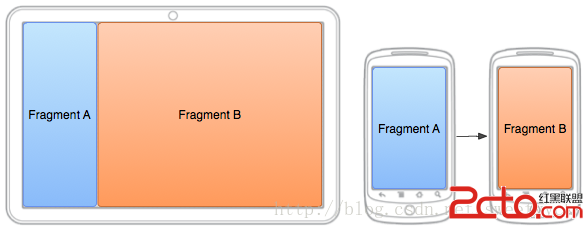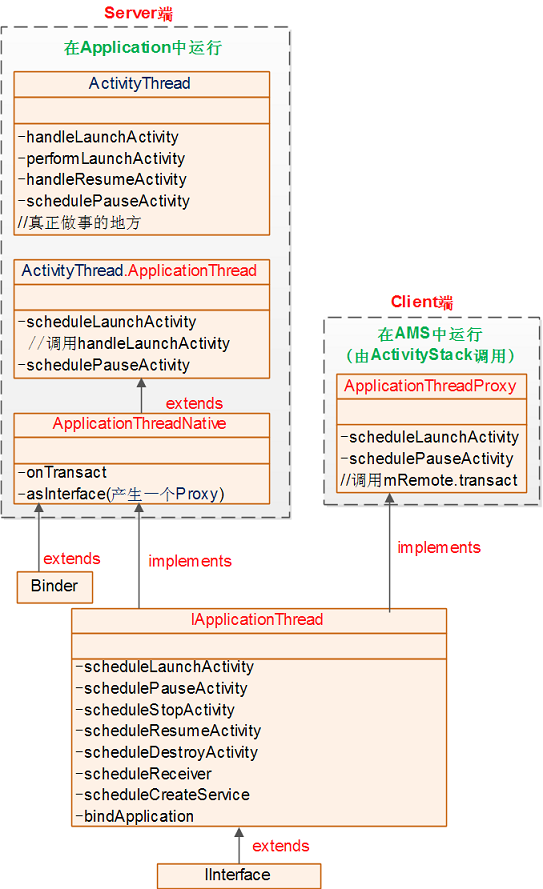編輯:關於Android編程
先占個位置,下次翻譯 :p
When designing your application to support a wide range of screen sizes, you can reuse your fragments in different layout configurations to optimize the user experience based on the available screen space.
For example, on a handset device it might be appropriate to display just one fragment at a time for a single-pane user interface. Conversely, you may want to set fragments side-by-side on a tablet which has a wider screen size to display more information to the user.

Figure 1. Two fragments, displayed in different configurations for the same activity on different screen sizes. On a large screen, both fragments fit side by side, but on a handset device, only one fragment fits at a time so the fragments must replace each other as the user navigates.
The FragmentManager class
provides methods that allow you to add, remove, and replace fragments to an activity at runtime in order to create a dynamic experience.
Rather than defining the fragments for an activity in the layout file—as shown in the previous
lesson with the
To perform a transaction such as add or remove a fragment, you must use the FragmentManager to
create aFragmentTransaction,
which provides APIs to add, remove, replace, and perform other fragment transactions.
If your activity allows the fragments to be removed and replaced, you should add the initial fragment(s) to the activity during the activity's onCreate() method.
An important rule when dealing with fragments—especially those that you add at runtime—is that the fragment must have a container View in
the layout in which the fragment's layout will reside.
The following layout is an alternative to the layout shown in the previous
lesson that shows only one fragment at a time. In order to replace one fragment with another, the activity's layout includes an empty FrameLayout that
acts as the fragment container.
Notice that the filename is the same as the layout file in the previous lesson, but the layout directory does nothave the large qualifier,
so this layout is used when the device screen is smaller than large because the screen does not fit both fragments at the same time.
res/layout/news_articles.xml:
<frameLayout xmlns:android="http://schemas.android.com/apk/res/android"
android:id="@+id/fragment_container"
android:layout_width="match_parent"
android:layout_height="match_parent" />
Inside your activity, call getSupportFragmentManager() to
get a FragmentManager using
the Support Library APIs. Then call beginTransaction() to
create a FragmentTransaction and
call add() to
add a fragment.
You can perform multiple fragment transaction for the activity using the same FragmentTransaction.
When you're ready to make the changes, you must call commit().
For example, here's how to add a fragment to the previous layout:
import android.os.Bundle;
import android.support.v4.app.FragmentActivity;
public class MainActivity extends FragmentActivity {
@Override
public void onCreate(Bundle savedInstanceState) {
super.onCreate(savedInstanceState);
setContentView(R.layout.news_articles);
// Check that the activity is using the layout version with
// the fragment_container FrameLayout
if (findViewById(R.id.fragment_container) != null) {
// However, if we're being restored from a previous state,
// then we don't need to do anything and should return or else
// we could end up with overlapping fragments.
if (savedInstanceState != null) {
return;
}
// Create a new Fragment to be placed in the activity layout
HeadlinesFragment firstFragment = new HeadlinesFragment();
// In case this activity was started with special instructions from an
// Intent, pass the Intent's extras to the fragment as arguments
firstFragment.setArguments(getIntent().getExtras());
// Add the fragment to the 'fragment_container' FrameLayout
getSupportFragmentManager().beginTransaction()
.add(R.id.fragment_container, firstFragment).commit();
}
}
}
Because the fragment has been added to the FrameLayout container
at runtime—instead of defining it in the activity's layout with a
The procedure to replace a fragment is similar to adding one, but requires the replace() method
instead ofadd().
Keep in mind that when you perform fragment transactions, such as replace or remove one, it's often appropriate to allow the user to navigate backward and "undo" the change. To allow the user to navigate backward
through the fragment transactions, you must call addToBackStack() before
you commit theFragmentTransaction.
Note: When you remove or replace a fragment and add the transaction to the back stack, the fragment that is removed is stopped (not destroyed). If the user navigates back to restore the fragment, it restarts. If you do not add the transaction to the back stack, then the fragment is destroyed when removed or replaced.
Example of replacing one fragment with another:
// Create fragment and give it an argument specifying the article it should show ArticleFragment newFragment = new ArticleFragment(); Bundle args = new Bundle(); args.putInt(ArticleFragment.ARG_POSITION, position); newFragment.setArguments(args); FragmentTransaction transaction = getSupportFragmentManager().beginTransaction(); // Replace whatever is in the fragment_container view with this fragment, // and add the transaction to the back stack so the user can navigate back transaction.replace(R.id.fragment_container, newFragment); transaction.addToBackStack(null); // Commit the transaction transaction.commit();
The addToBackStack() method
takes an optional string parameter that specifies a unique name for the transaction. The name isn't needed unless you plan to perform advanced fragment operations using theFragmentManager.BackStackEntry APIs.
 手機酷狗和電腦酷狗不同步了怎麼辦
手機酷狗和電腦酷狗不同步了怎麼辦
手機酷狗和電腦酷狗怎麼同步呢?手機酷狗和電腦酷狗的歌曲可以同步嗎?答案當然是肯定的!下面,小編將在下文演示手機酷狗和電腦酷狗同步教程,我們在電腦酷狗聽的歌曲
 Android雷達掃描動態界面制作
Android雷達掃描動態界面制作
先看看效果圖:源碼:package com.zihao.radar; import android.app.Activity; import android.os.Bu
 Android官方MVP架構示例項目解讀
Android官方MVP架構示例項目解讀
綜述對於MVP (Model View Presenter)架構是從著名的MVC(Model View Controller)架構演變而來的。而對於Android應用的開
 Android 6.0 應用啟動全流程源碼分析
Android 6.0 應用啟動全流程源碼分析
今天是國慶,首先祝大家國慶快樂!漫漫國慶長假,然而我卻只能宅宿捨,但時間總不能這樣白白浪費了,這樣的時候,沒出去浪,那麼,就總結一下前段時間通過Android源碼分析了一